HSC Module: Safeguarding Vulnerable Individuals Report Analysis
VerifiedAdded on 2019/12/03
|13
|3811
|191
Report
AI Summary
This report on safeguarding in health and social care explores the vulnerability of individuals to abuse, examining risk factors such as lack of parenting skills, substance abuse, and cultural influences. It delves into the strengths and weaknesses of current legislation and policies, including CRB checks and whistleblowing procedures, and assesses existing working practices and strategies aimed at minimizing abuse. The report analyzes the impact of social and cultural factors on different types of abuse, providing insights into potential improvements in working practices and strategies to enhance the protection of vulnerable individuals. The report covers various aspects of safeguarding, including child and elder abuse, and discusses the importance of early detection and prevention measures.
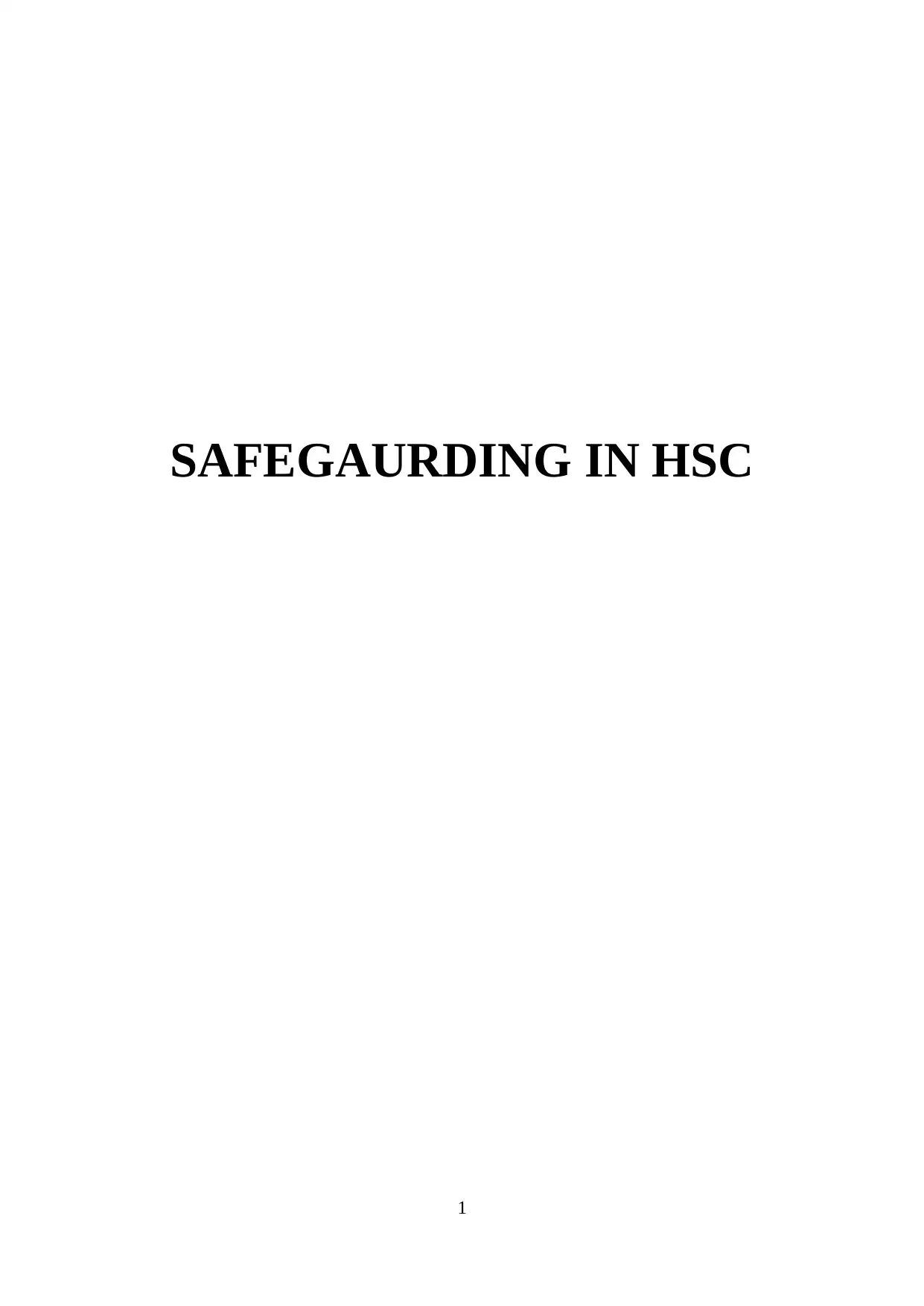
SAFEGAURDING IN HSC
1
1
Paraphrase This Document
Need a fresh take? Get an instant paraphrase of this document with our AI Paraphraser
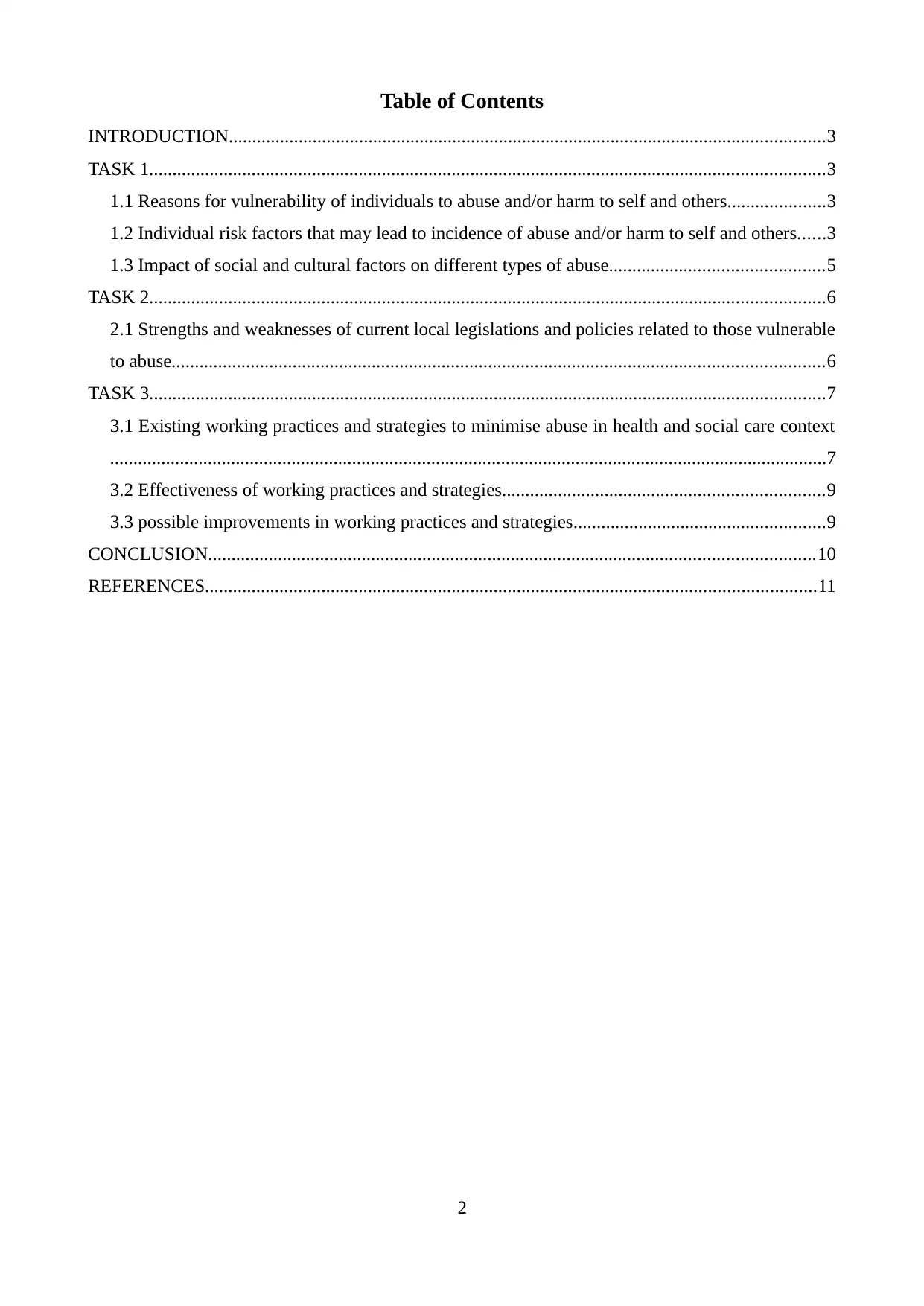
Table of Contents
INTRODUCTION................................................................................................................................3
TASK 1.................................................................................................................................................3
1.1 Reasons for vulnerability of individuals to abuse and/or harm to self and others.....................3
1.2 Individual risk factors that may lead to incidence of abuse and/or harm to self and others......3
1.3 Impact of social and cultural factors on different types of abuse..............................................5
TASK 2.................................................................................................................................................6
2.1 Strengths and weaknesses of current local legislations and policies related to those vulnerable
to abuse............................................................................................................................................6
TASK 3.................................................................................................................................................7
3.1 Existing working practices and strategies to minimise abuse in health and social care context
..........................................................................................................................................................7
3.2 Effectiveness of working practices and strategies.....................................................................9
3.3 possible improvements in working practices and strategies......................................................9
CONCLUSION..................................................................................................................................10
REFERENCES...................................................................................................................................11
2
INTRODUCTION................................................................................................................................3
TASK 1.................................................................................................................................................3
1.1 Reasons for vulnerability of individuals to abuse and/or harm to self and others.....................3
1.2 Individual risk factors that may lead to incidence of abuse and/or harm to self and others......3
1.3 Impact of social and cultural factors on different types of abuse..............................................5
TASK 2.................................................................................................................................................6
2.1 Strengths and weaknesses of current local legislations and policies related to those vulnerable
to abuse............................................................................................................................................6
TASK 3.................................................................................................................................................7
3.1 Existing working practices and strategies to minimise abuse in health and social care context
..........................................................................................................................................................7
3.2 Effectiveness of working practices and strategies.....................................................................9
3.3 possible improvements in working practices and strategies......................................................9
CONCLUSION..................................................................................................................................10
REFERENCES...................................................................................................................................11
2
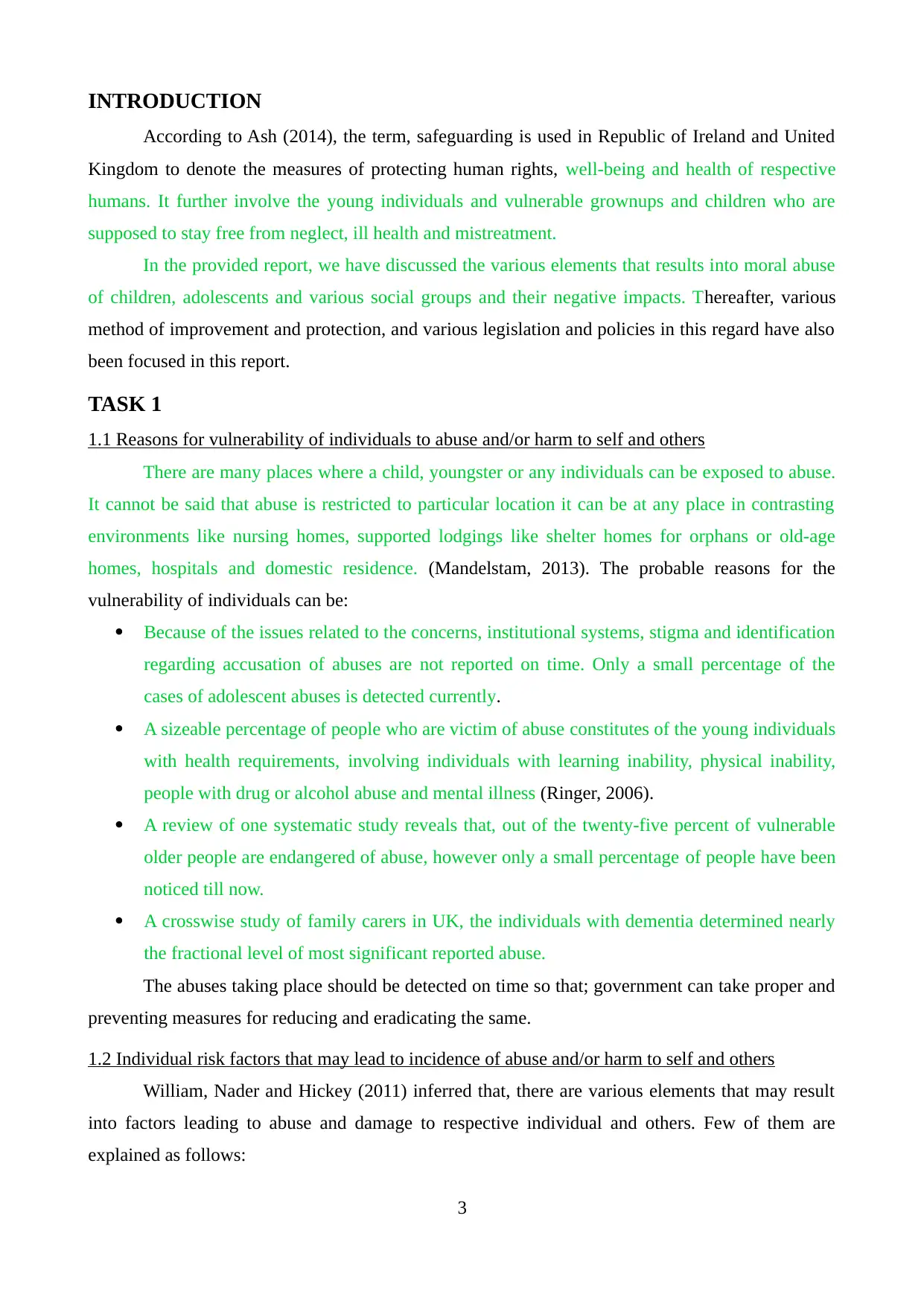
INTRODUCTION
According to Ash (2014), the term, safeguarding is used in Republic of Ireland and United
Kingdom to denote the measures of protecting human rights, well-being and health of respective
humans. It further involve the young individuals and vulnerable grownups and children who are
supposed to stay free from neglect, ill health and mistreatment.
In the provided report, we have discussed the various elements that results into moral abuse
of children, adolescents and various social groups and their negative impacts. Thereafter, various
method of improvement and protection, and various legislation and policies in this regard have also
been focused in this report.
TASK 1
1.1 Reasons for vulnerability of individuals to abuse and/or harm to self and others
There are many places where a child, youngster or any individuals can be exposed to abuse.
It cannot be said that abuse is restricted to particular location it can be at any place in contrasting
environments like nursing homes, supported lodgings like shelter homes for orphans or old-age
homes, hospitals and domestic residence. (Mandelstam, 2013). The probable reasons for the
vulnerability of individuals can be:
Because of the issues related to the concerns, institutional systems, stigma and identification
regarding accusation of abuses are not reported on time. Only a small percentage of the
cases of adolescent abuses is detected currently.
A sizeable percentage of people who are victim of abuse constitutes of the young individuals
with health requirements, involving individuals with learning inability, physical inability,
people with drug or alcohol abuse and mental illness (Ringer, 2006).
A review of one systematic study reveals that, out of the twenty-five percent of vulnerable
older people are endangered of abuse, however only a small percentage of people have been
noticed till now.
A crosswise study of family carers in UK, the individuals with dementia determined nearly
the fractional level of most significant reported abuse.
The abuses taking place should be detected on time so that; government can take proper and
preventing measures for reducing and eradicating the same.
1.2 Individual risk factors that may lead to incidence of abuse and/or harm to self and others
William, Nader and Hickey (2011) inferred that, there are various elements that may result
into factors leading to abuse and damage to respective individual and others. Few of them are
explained as follows:
3
According to Ash (2014), the term, safeguarding is used in Republic of Ireland and United
Kingdom to denote the measures of protecting human rights, well-being and health of respective
humans. It further involve the young individuals and vulnerable grownups and children who are
supposed to stay free from neglect, ill health and mistreatment.
In the provided report, we have discussed the various elements that results into moral abuse
of children, adolescents and various social groups and their negative impacts. Thereafter, various
method of improvement and protection, and various legislation and policies in this regard have also
been focused in this report.
TASK 1
1.1 Reasons for vulnerability of individuals to abuse and/or harm to self and others
There are many places where a child, youngster or any individuals can be exposed to abuse.
It cannot be said that abuse is restricted to particular location it can be at any place in contrasting
environments like nursing homes, supported lodgings like shelter homes for orphans or old-age
homes, hospitals and domestic residence. (Mandelstam, 2013). The probable reasons for the
vulnerability of individuals can be:
Because of the issues related to the concerns, institutional systems, stigma and identification
regarding accusation of abuses are not reported on time. Only a small percentage of the
cases of adolescent abuses is detected currently.
A sizeable percentage of people who are victim of abuse constitutes of the young individuals
with health requirements, involving individuals with learning inability, physical inability,
people with drug or alcohol abuse and mental illness (Ringer, 2006).
A review of one systematic study reveals that, out of the twenty-five percent of vulnerable
older people are endangered of abuse, however only a small percentage of people have been
noticed till now.
A crosswise study of family carers in UK, the individuals with dementia determined nearly
the fractional level of most significant reported abuse.
The abuses taking place should be detected on time so that; government can take proper and
preventing measures for reducing and eradicating the same.
1.2 Individual risk factors that may lead to incidence of abuse and/or harm to self and others
William, Nader and Hickey (2011) inferred that, there are various elements that may result
into factors leading to abuse and damage to respective individual and others. Few of them are
explained as follows:
3
⊘ This is a preview!⊘
Do you want full access?
Subscribe today to unlock all pages.

Trusted by 1+ million students worldwide
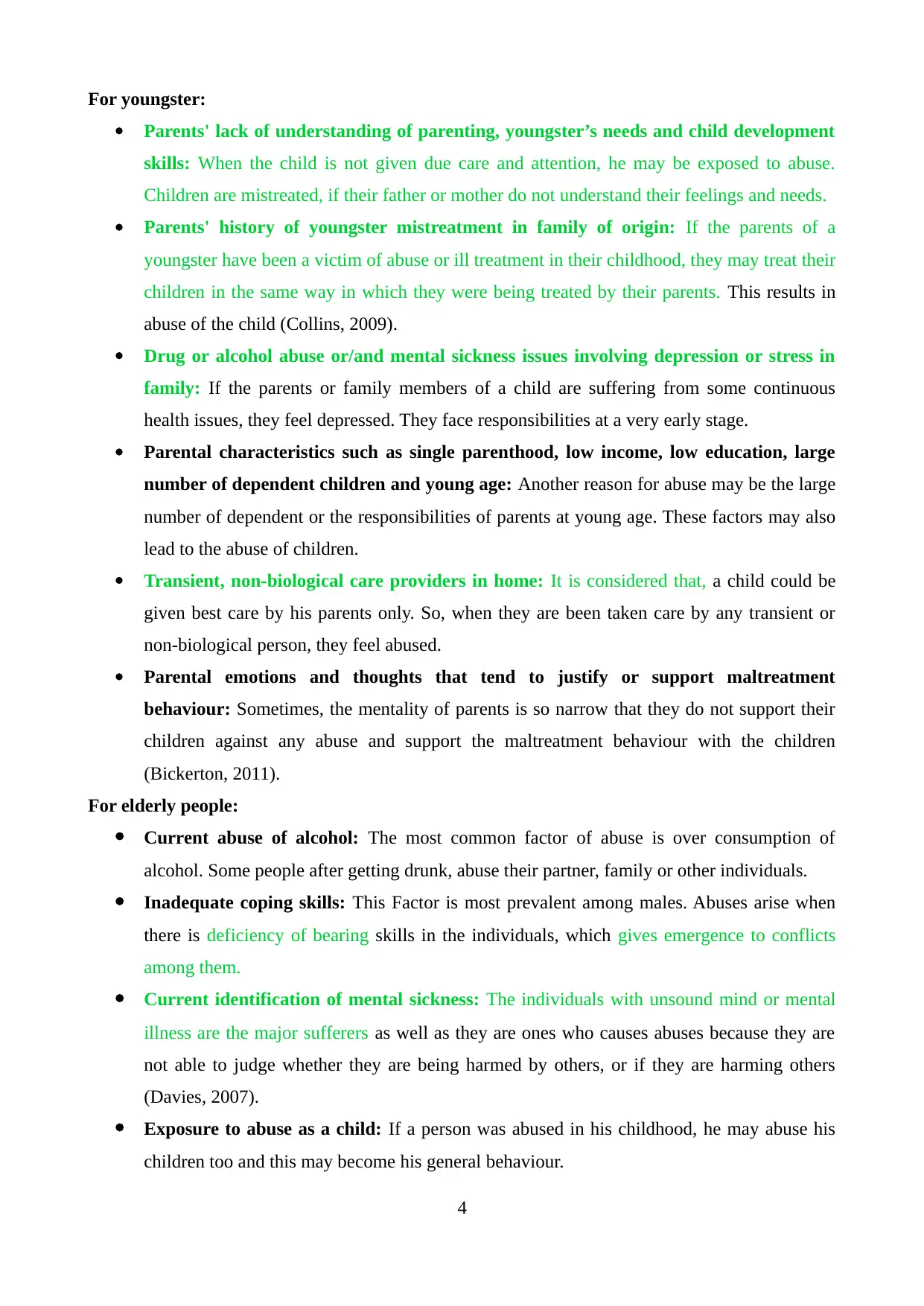
For youngster:
Parents' lack of understanding of parenting, youngster’s needs and child development
skills: When the child is not given due care and attention, he may be exposed to abuse.
Children are mistreated, if their father or mother do not understand their feelings and needs.
Parents' history of youngster mistreatment in family of origin: If the parents of a
youngster have been a victim of abuse or ill treatment in their childhood, they may treat their
children in the same way in which they were being treated by their parents. This results in
abuse of the child (Collins, 2009).
Drug or alcohol abuse or/and mental sickness issues involving depression or stress in
family: If the parents or family members of a child are suffering from some continuous
health issues, they feel depressed. They face responsibilities at a very early stage.
Parental characteristics such as single parenthood, low income, low education, large
number of dependent children and young age: Another reason for abuse may be the large
number of dependent or the responsibilities of parents at young age. These factors may also
lead to the abuse of children.
Transient, non-biological care providers in home: It is considered that, a child could be
given best care by his parents only. So, when they are been taken care by any transient or
non-biological person, they feel abused.
Parental emotions and thoughts that tend to justify or support maltreatment
behaviour: Sometimes, the mentality of parents is so narrow that they do not support their
children against any abuse and support the maltreatment behaviour with the children
(Bickerton, 2011).
For elderly people:
Current abuse of alcohol: The most common factor of abuse is over consumption of
alcohol. Some people after getting drunk, abuse their partner, family or other individuals.
Inadequate coping skills: This Factor is most prevalent among males. Abuses arise when
there is deficiency of bearing skills in the individuals, which gives emergence to conflicts
among them.
Current identification of mental sickness: The individuals with unsound mind or mental
illness are the major sufferers as well as they are ones who causes abuses because they are
not able to judge whether they are being harmed by others, or if they are harming others
(Davies, 2007).
Exposure to abuse as a child: If a person was abused in his childhood, he may abuse his
children too and this may become his general behaviour.
4
Parents' lack of understanding of parenting, youngster’s needs and child development
skills: When the child is not given due care and attention, he may be exposed to abuse.
Children are mistreated, if their father or mother do not understand their feelings and needs.
Parents' history of youngster mistreatment in family of origin: If the parents of a
youngster have been a victim of abuse or ill treatment in their childhood, they may treat their
children in the same way in which they were being treated by their parents. This results in
abuse of the child (Collins, 2009).
Drug or alcohol abuse or/and mental sickness issues involving depression or stress in
family: If the parents or family members of a child are suffering from some continuous
health issues, they feel depressed. They face responsibilities at a very early stage.
Parental characteristics such as single parenthood, low income, low education, large
number of dependent children and young age: Another reason for abuse may be the large
number of dependent or the responsibilities of parents at young age. These factors may also
lead to the abuse of children.
Transient, non-biological care providers in home: It is considered that, a child could be
given best care by his parents only. So, when they are been taken care by any transient or
non-biological person, they feel abused.
Parental emotions and thoughts that tend to justify or support maltreatment
behaviour: Sometimes, the mentality of parents is so narrow that they do not support their
children against any abuse and support the maltreatment behaviour with the children
(Bickerton, 2011).
For elderly people:
Current abuse of alcohol: The most common factor of abuse is over consumption of
alcohol. Some people after getting drunk, abuse their partner, family or other individuals.
Inadequate coping skills: This Factor is most prevalent among males. Abuses arise when
there is deficiency of bearing skills in the individuals, which gives emergence to conflicts
among them.
Current identification of mental sickness: The individuals with unsound mind or mental
illness are the major sufferers as well as they are ones who causes abuses because they are
not able to judge whether they are being harmed by others, or if they are harming others
(Davies, 2007).
Exposure to abuse as a child: If a person was abused in his childhood, he may abuse his
children too and this may become his general behaviour.
4
Paraphrase This Document
Need a fresh take? Get an instant paraphrase of this document with our AI Paraphraser

High levels of hostility: When a person opposes or is being opposed by others frequently
and suffers from an unfriendly treatment, it may result in abuse.
Assumption of care providing responsibilities at an primal age: If an individual is given
the responsibilities of providing care at an early age, it can lead to maltreatment of the
caregiver as well the person being taken care of (Brayne, Carr and Goosey, 2015).
Inadequate or poor training or preparation for care giving responsibilities: Another
reason for abuse may be that, the parents have inadequate knowledge or poor training or
preparation for meeting the responsibilities.
1.3 Impact of social and cultural factors on different types of abuse
Various cultural and societal factors have several impacts on the assorted kinds of abuses
like physical, psychological, sexual, and substance abuse. Some of the elements responsible for the
same are as follows:
Parental influence: Parents influence the children tremendously (Hewitt, 2009). The
children having parents who are addicted to smoke or alcohol are twice probable to be
smokers in future. Therefore, if the father or mother have a common habit of consuming
alcohol and smoking then their kids are likely to follow the identical practice.
Family structure: The level of parental education and socio-economic factors have an
inverse relationship with the use of drugs and alcohol. The other factors that lead to the
alcohol and drug abuse among adolescents are divorce among parents, single parenting,
marital discord, etc. Parents having a poor control or monitoring over children also
contribute in developing these habits in their children.
Peer influence: Friends have the greatest impact on an individual. The initiation of drinking
and smoking occurs among friends generally which in-turn gives rise to the alcohol and drug
abuse later (Nolan, Moonie and Lavers, 2005).
Role model: TV ans Film stars, fashion models and pop stars make alcohol and drug
consumption attractive. In order to adopt their style people start consuming drugs and
alcohol.
Advertising and promotion: Advertising and promotion has a huge impact. If used
properly, it can help in reducing the habits of alcohol and smoking among people.
Poverty: Sexual abuse is much common among poor people. Poor people do not have much
place for living. Being close together all the times results in sexual abuse at times.
Lack of organization assistance from police and legal bodies: Many time police and legal
bodies do not support the individual who has been sexually mistreated. They generally
5
and suffers from an unfriendly treatment, it may result in abuse.
Assumption of care providing responsibilities at an primal age: If an individual is given
the responsibilities of providing care at an early age, it can lead to maltreatment of the
caregiver as well the person being taken care of (Brayne, Carr and Goosey, 2015).
Inadequate or poor training or preparation for care giving responsibilities: Another
reason for abuse may be that, the parents have inadequate knowledge or poor training or
preparation for meeting the responsibilities.
1.3 Impact of social and cultural factors on different types of abuse
Various cultural and societal factors have several impacts on the assorted kinds of abuses
like physical, psychological, sexual, and substance abuse. Some of the elements responsible for the
same are as follows:
Parental influence: Parents influence the children tremendously (Hewitt, 2009). The
children having parents who are addicted to smoke or alcohol are twice probable to be
smokers in future. Therefore, if the father or mother have a common habit of consuming
alcohol and smoking then their kids are likely to follow the identical practice.
Family structure: The level of parental education and socio-economic factors have an
inverse relationship with the use of drugs and alcohol. The other factors that lead to the
alcohol and drug abuse among adolescents are divorce among parents, single parenting,
marital discord, etc. Parents having a poor control or monitoring over children also
contribute in developing these habits in their children.
Peer influence: Friends have the greatest impact on an individual. The initiation of drinking
and smoking occurs among friends generally which in-turn gives rise to the alcohol and drug
abuse later (Nolan, Moonie and Lavers, 2005).
Role model: TV ans Film stars, fashion models and pop stars make alcohol and drug
consumption attractive. In order to adopt their style people start consuming drugs and
alcohol.
Advertising and promotion: Advertising and promotion has a huge impact. If used
properly, it can help in reducing the habits of alcohol and smoking among people.
Poverty: Sexual abuse is much common among poor people. Poor people do not have much
place for living. Being close together all the times results in sexual abuse at times.
Lack of organization assistance from police and legal bodies: Many time police and legal
bodies do not support the individual who has been sexually mistreated. They generally
5
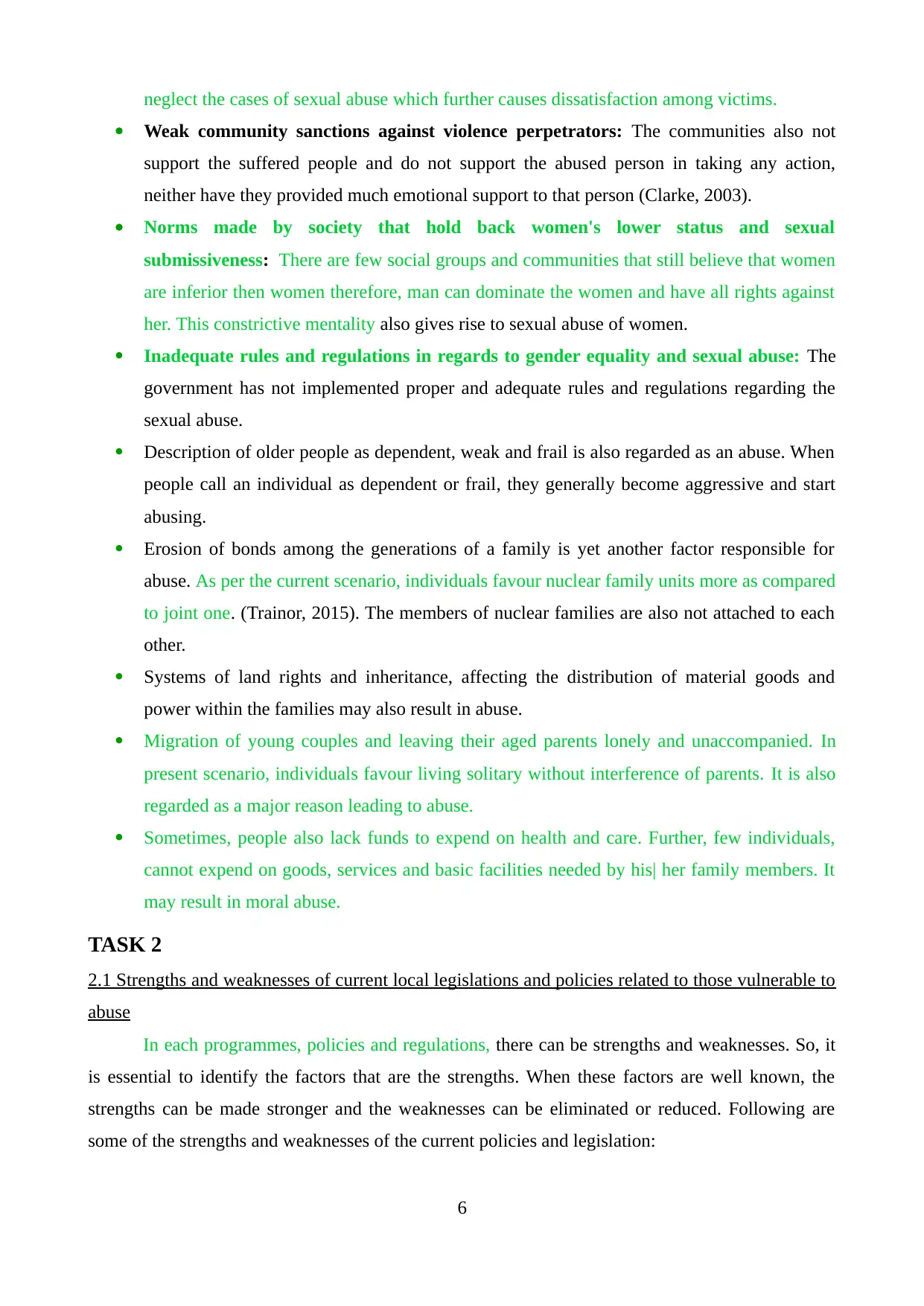
neglect the cases of sexual abuse which further causes dissatisfaction among victims.
Weak community sanctions against violence perpetrators: The communities also not
support the suffered people and do not support the abused person in taking any action,
neither have they provided much emotional support to that person (Clarke, 2003).
Norms made by society that hold back women's lower status and sexual
submissiveness: There are few social groups and communities that still believe that women
are inferior then women therefore, man can dominate the women and have all rights against
her. This constrictive mentality also gives rise to sexual abuse of women.
Inadequate rules and regulations in regards to gender equality and sexual abuse: The
government has not implemented proper and adequate rules and regulations regarding the
sexual abuse.
Description of older people as dependent, weak and frail is also regarded as an abuse. When
people call an individual as dependent or frail, they generally become aggressive and start
abusing.
Erosion of bonds among the generations of a family is yet another factor responsible for
abuse. As per the current scenario, individuals favour nuclear family units more as compared
to joint one. (Trainor, 2015). The members of nuclear families are also not attached to each
other.
Systems of land rights and inheritance, affecting the distribution of material goods and
power within the families may also result in abuse.
Migration of young couples and leaving their aged parents lonely and unaccompanied. In
present scenario, individuals favour living solitary without interference of parents. It is also
regarded as a major reason leading to abuse.
Sometimes, people also lack funds to expend on health and care. Further, few individuals,
cannot expend on goods, services and basic facilities needed by his| her family members. It
may result in moral abuse.
TASK 2
2.1 Strengths and weaknesses of current local legislations and policies related to those vulnerable to
abuse
In each programmes, policies and regulations, there can be strengths and weaknesses. So, it
is essential to identify the factors that are the strengths. When these factors are well known, the
strengths can be made stronger and the weaknesses can be eliminated or reduced. Following are
some of the strengths and weaknesses of the current policies and legislation:
6
Weak community sanctions against violence perpetrators: The communities also not
support the suffered people and do not support the abused person in taking any action,
neither have they provided much emotional support to that person (Clarke, 2003).
Norms made by society that hold back women's lower status and sexual
submissiveness: There are few social groups and communities that still believe that women
are inferior then women therefore, man can dominate the women and have all rights against
her. This constrictive mentality also gives rise to sexual abuse of women.
Inadequate rules and regulations in regards to gender equality and sexual abuse: The
government has not implemented proper and adequate rules and regulations regarding the
sexual abuse.
Description of older people as dependent, weak and frail is also regarded as an abuse. When
people call an individual as dependent or frail, they generally become aggressive and start
abusing.
Erosion of bonds among the generations of a family is yet another factor responsible for
abuse. As per the current scenario, individuals favour nuclear family units more as compared
to joint one. (Trainor, 2015). The members of nuclear families are also not attached to each
other.
Systems of land rights and inheritance, affecting the distribution of material goods and
power within the families may also result in abuse.
Migration of young couples and leaving their aged parents lonely and unaccompanied. In
present scenario, individuals favour living solitary without interference of parents. It is also
regarded as a major reason leading to abuse.
Sometimes, people also lack funds to expend on health and care. Further, few individuals,
cannot expend on goods, services and basic facilities needed by his| her family members. It
may result in moral abuse.
TASK 2
2.1 Strengths and weaknesses of current local legislations and policies related to those vulnerable to
abuse
In each programmes, policies and regulations, there can be strengths and weaknesses. So, it
is essential to identify the factors that are the strengths. When these factors are well known, the
strengths can be made stronger and the weaknesses can be eliminated or reduced. Following are
some of the strengths and weaknesses of the current policies and legislation:
6
⊘ This is a preview!⊘
Do you want full access?
Subscribe today to unlock all pages.

Trusted by 1+ million students worldwide
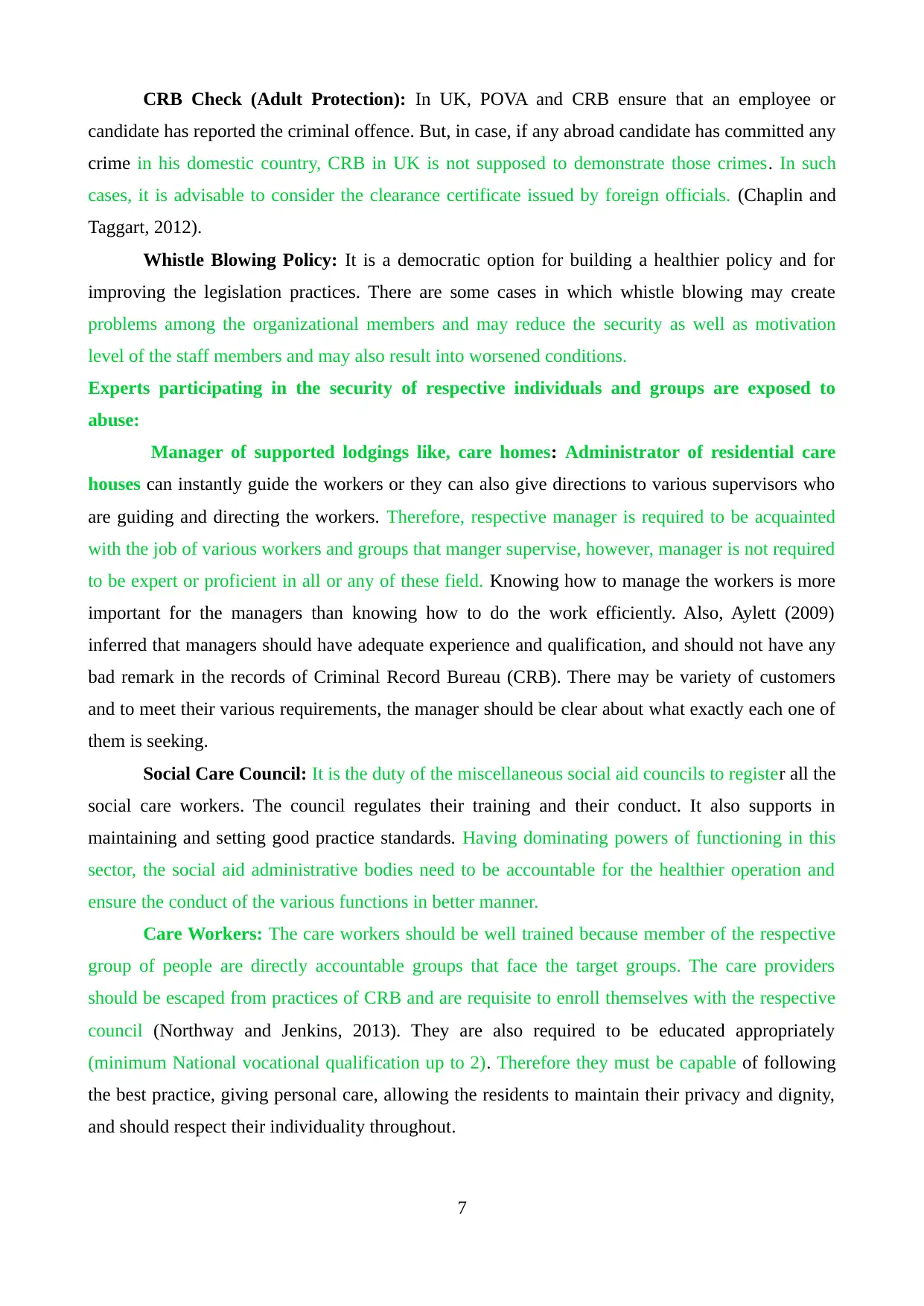
CRB Check (Adult Protection): In UK, POVA and CRB ensure that an employee or
candidate has reported the criminal offence. But, in case, if any abroad candidate has committed any
crime in his domestic country, CRB in UK is not supposed to demonstrate those crimes. In such
cases, it is advisable to consider the clearance certificate issued by foreign officials. (Chaplin and
Taggart, 2012).
Whistle Blowing Policy: It is a democratic option for building a healthier policy and for
improving the legislation practices. There are some cases in which whistle blowing may create
problems among the organizational members and may reduce the security as well as motivation
level of the staff members and may also result into worsened conditions.
Experts participating in the security of respective individuals and groups are exposed to
abuse:
Manager of supported lodgings like, care homes: Administrator of residential care
houses can instantly guide the workers or they can also give directions to various supervisors who
are guiding and directing the workers. Therefore, respective manager is required to be acquainted
with the job of various workers and groups that manger supervise, however, manager is not required
to be expert or proficient in all or any of these field. Knowing how to manage the workers is more
important for the managers than knowing how to do the work efficiently. Also, Aylett (2009)
inferred that managers should have adequate experience and qualification, and should not have any
bad remark in the records of Criminal Record Bureau (CRB). There may be variety of customers
and to meet their various requirements, the manager should be clear about what exactly each one of
them is seeking.
Social Care Council: It is the duty of the miscellaneous social aid councils to register all the
social care workers. The council regulates their training and their conduct. It also supports in
maintaining and setting good practice standards. Having dominating powers of functioning in this
sector, the social aid administrative bodies need to be accountable for the healthier operation and
ensure the conduct of the various functions in better manner.
Care Workers: The care workers should be well trained because member of the respective
group of people are directly accountable groups that face the target groups. The care providers
should be escaped from practices of CRB and are requisite to enroll themselves with the respective
council (Northway and Jenkins, 2013). They are also required to be educated appropriately
(minimum National vocational qualification up to 2). Therefore they must be capable of following
the best practice, giving personal care, allowing the residents to maintain their privacy and dignity,
and should respect their individuality throughout.
7
candidate has reported the criminal offence. But, in case, if any abroad candidate has committed any
crime in his domestic country, CRB in UK is not supposed to demonstrate those crimes. In such
cases, it is advisable to consider the clearance certificate issued by foreign officials. (Chaplin and
Taggart, 2012).
Whistle Blowing Policy: It is a democratic option for building a healthier policy and for
improving the legislation practices. There are some cases in which whistle blowing may create
problems among the organizational members and may reduce the security as well as motivation
level of the staff members and may also result into worsened conditions.
Experts participating in the security of respective individuals and groups are exposed to
abuse:
Manager of supported lodgings like, care homes: Administrator of residential care
houses can instantly guide the workers or they can also give directions to various supervisors who
are guiding and directing the workers. Therefore, respective manager is required to be acquainted
with the job of various workers and groups that manger supervise, however, manager is not required
to be expert or proficient in all or any of these field. Knowing how to manage the workers is more
important for the managers than knowing how to do the work efficiently. Also, Aylett (2009)
inferred that managers should have adequate experience and qualification, and should not have any
bad remark in the records of Criminal Record Bureau (CRB). There may be variety of customers
and to meet their various requirements, the manager should be clear about what exactly each one of
them is seeking.
Social Care Council: It is the duty of the miscellaneous social aid councils to register all the
social care workers. The council regulates their training and their conduct. It also supports in
maintaining and setting good practice standards. Having dominating powers of functioning in this
sector, the social aid administrative bodies need to be accountable for the healthier operation and
ensure the conduct of the various functions in better manner.
Care Workers: The care workers should be well trained because member of the respective
group of people are directly accountable groups that face the target groups. The care providers
should be escaped from practices of CRB and are requisite to enroll themselves with the respective
council (Northway and Jenkins, 2013). They are also required to be educated appropriately
(minimum National vocational qualification up to 2). Therefore they must be capable of following
the best practice, giving personal care, allowing the residents to maintain their privacy and dignity,
and should respect their individuality throughout.
7
Paraphrase This Document
Need a fresh take? Get an instant paraphrase of this document with our AI Paraphraser
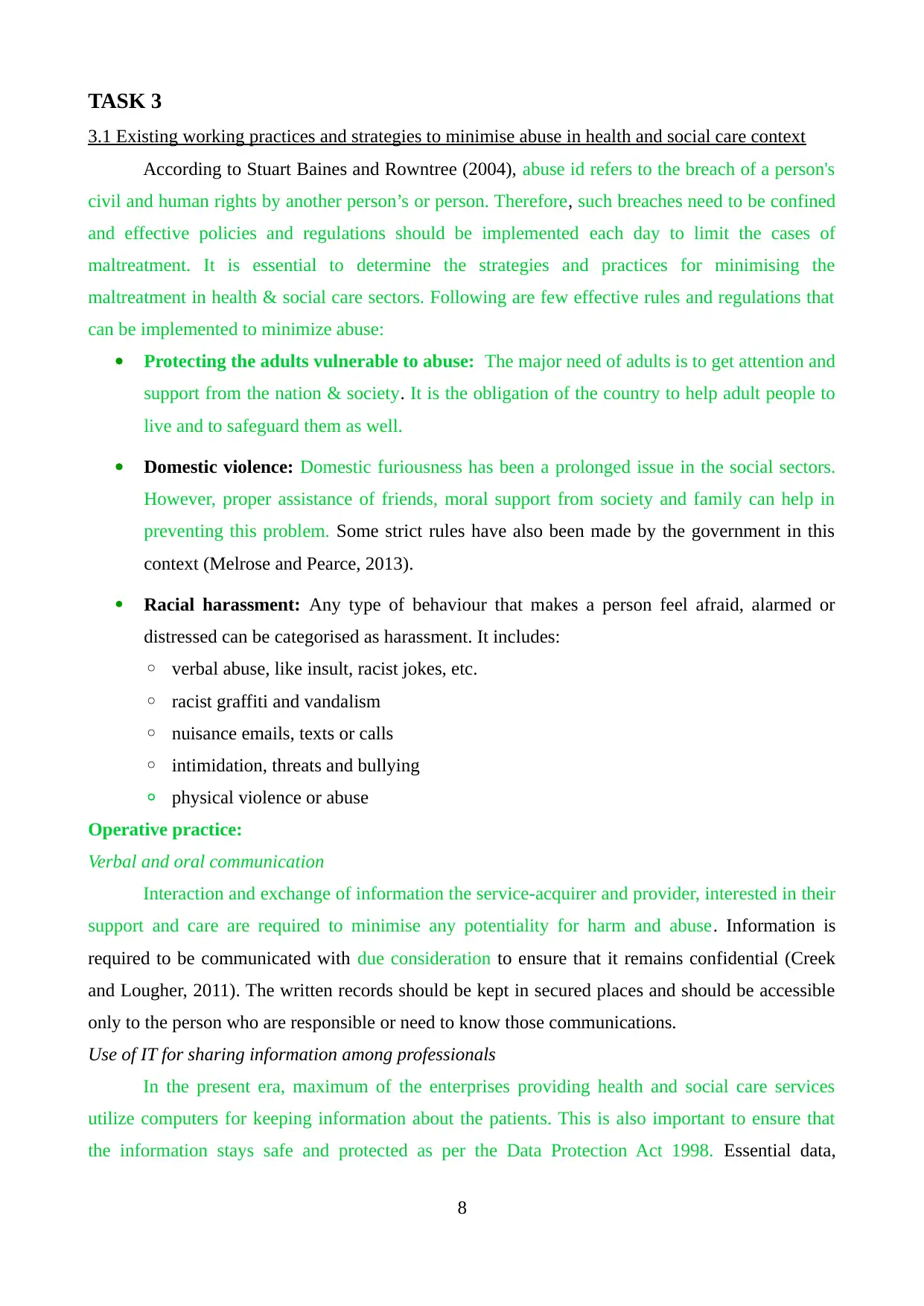
TASK 3
3.1 Existing working practices and strategies to minimise abuse in health and social care context
According to Stuart Baines and Rowntree (2004), abuse id refers to the breach of a person's
civil and human rights by another person’s or person. Therefore, such breaches need to be confined
and effective policies and regulations should be implemented each day to limit the cases of
maltreatment. It is essential to determine the strategies and practices for minimising the
maltreatment in health & social care sectors. Following are few effective rules and regulations that
can be implemented to minimize abuse:
Protecting the adults vulnerable to abuse: The major need of adults is to get attention and
support from the nation & society. It is the obligation of the country to help adult people to
live and to safeguard them as well.
Domestic violence: Domestic furiousness has been a prolonged issue in the social sectors.
However, proper assistance of friends, moral support from society and family can help in
preventing this problem. Some strict rules have also been made by the government in this
context (Melrose and Pearce, 2013).
Racial harassment: Any type of behaviour that makes a person feel afraid, alarmed or
distressed can be categorised as harassment. It includes:
◦ verbal abuse, like insult, racist jokes, etc.
◦ racist graffiti and vandalism
◦ nuisance emails, texts or calls
◦ intimidation, threats and bullying
◦ physical violence or abuse
Operative practice:
Verbal and oral communication
Interaction and exchange of information the service-acquirer and provider, interested in their
support and care are required to minimise any potentiality for harm and abuse. Information is
required to be communicated with due consideration to ensure that it remains confidential (Creek
and Lougher, 2011). The written records should be kept in secured places and should be accessible
only to the person who are responsible or need to know those communications.
Use of IT for sharing information among professionals
In the present era, maximum of the enterprises providing health and social care services
utilize computers for keeping information about the patients. This is also important to ensure that
the information stays safe and protected as per the Data Protection Act 1998. Essential data,
8
3.1 Existing working practices and strategies to minimise abuse in health and social care context
According to Stuart Baines and Rowntree (2004), abuse id refers to the breach of a person's
civil and human rights by another person’s or person. Therefore, such breaches need to be confined
and effective policies and regulations should be implemented each day to limit the cases of
maltreatment. It is essential to determine the strategies and practices for minimising the
maltreatment in health & social care sectors. Following are few effective rules and regulations that
can be implemented to minimize abuse:
Protecting the adults vulnerable to abuse: The major need of adults is to get attention and
support from the nation & society. It is the obligation of the country to help adult people to
live and to safeguard them as well.
Domestic violence: Domestic furiousness has been a prolonged issue in the social sectors.
However, proper assistance of friends, moral support from society and family can help in
preventing this problem. Some strict rules have also been made by the government in this
context (Melrose and Pearce, 2013).
Racial harassment: Any type of behaviour that makes a person feel afraid, alarmed or
distressed can be categorised as harassment. It includes:
◦ verbal abuse, like insult, racist jokes, etc.
◦ racist graffiti and vandalism
◦ nuisance emails, texts or calls
◦ intimidation, threats and bullying
◦ physical violence or abuse
Operative practice:
Verbal and oral communication
Interaction and exchange of information the service-acquirer and provider, interested in their
support and care are required to minimise any potentiality for harm and abuse. Information is
required to be communicated with due consideration to ensure that it remains confidential (Creek
and Lougher, 2011). The written records should be kept in secured places and should be accessible
only to the person who are responsible or need to know those communications.
Use of IT for sharing information among professionals
In the present era, maximum of the enterprises providing health and social care services
utilize computers for keeping information about the patients. This is also important to ensure that
the information stays safe and protected as per the Data Protection Act 1998. Essential data,
8
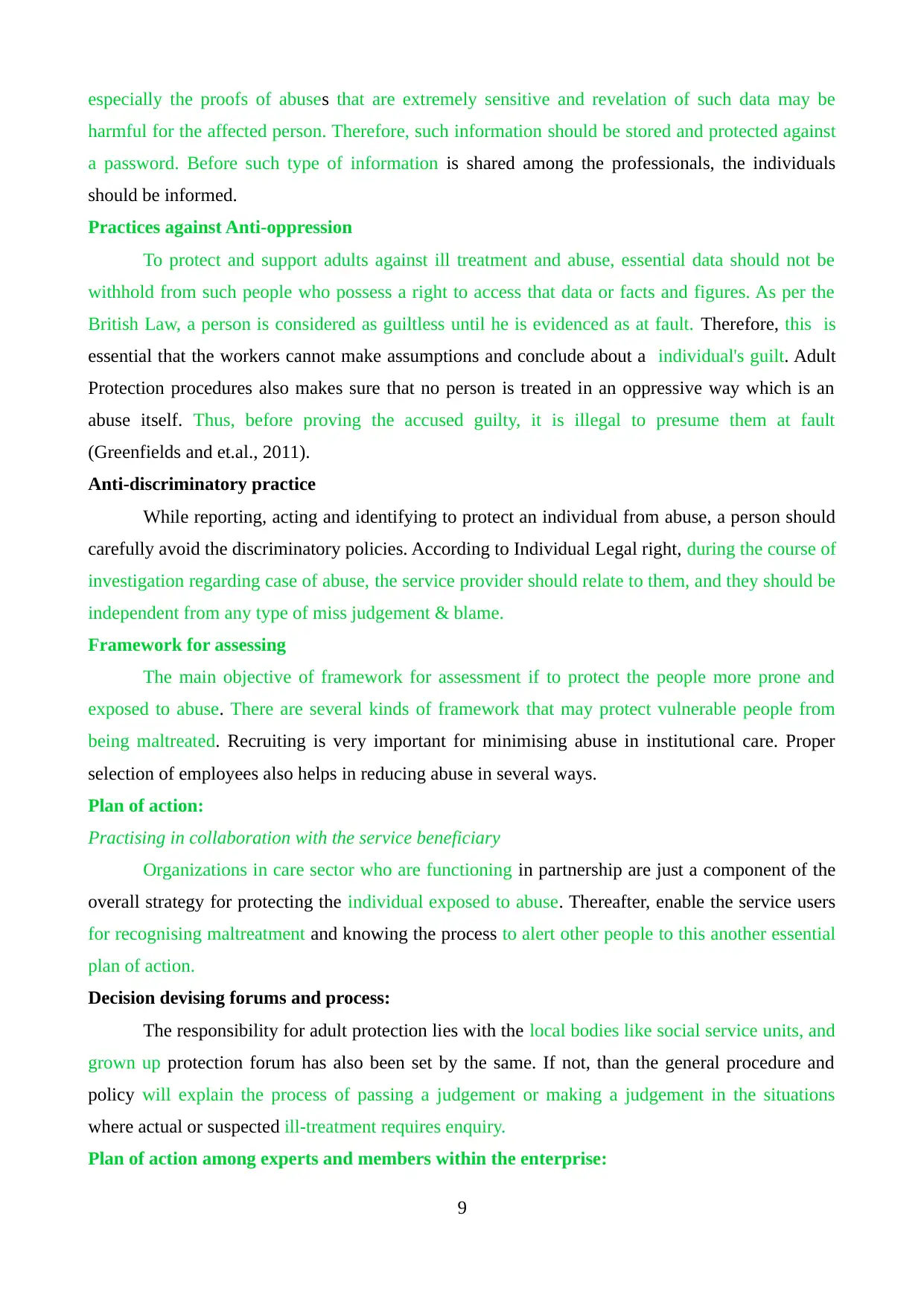
especially the proofs of abuses that are extremely sensitive and revelation of such data may be
harmful for the affected person. Therefore, such information should be stored and protected against
a password. Before such type of information is shared among the professionals, the individuals
should be informed.
Practices against Anti-oppression
To protect and support adults against ill treatment and abuse, essential data should not be
withhold from such people who possess a right to access that data or facts and figures. As per the
British Law, a person is considered as guiltless until he is evidenced as at fault. Therefore, this is
essential that the workers cannot make assumptions and conclude about a individual's guilt. Adult
Protection procedures also makes sure that no person is treated in an oppressive way which is an
abuse itself. Thus, before proving the accused guilty, it is illegal to presume them at fault
(Greenfields and et.al., 2011).
Anti-discriminatory practice
While reporting, acting and identifying to protect an individual from abuse, a person should
carefully avoid the discriminatory policies. According to Individual Legal right, during the course of
investigation regarding case of abuse, the service provider should relate to them, and they should be
independent from any type of miss judgement & blame.
Framework for assessing
The main objective of framework for assessment if to protect the people more prone and
exposed to abuse. There are several kinds of framework that may protect vulnerable people from
being maltreated. Recruiting is very important for minimising abuse in institutional care. Proper
selection of employees also helps in reducing abuse in several ways.
Plan of action:
Practising in collaboration with the service beneficiary
Organizations in care sector who are functioning in partnership are just a component of the
overall strategy for protecting the individual exposed to abuse. Thereafter, enable the service users
for recognising maltreatment and knowing the process to alert other people to this another essential
plan of action.
Decision devising forums and process:
The responsibility for adult protection lies with the local bodies like social service units, and
grown up protection forum has also been set by the same. If not, than the general procedure and
policy will explain the process of passing a judgement or making a judgement in the situations
where actual or suspected ill-treatment requires enquiry.
Plan of action among experts and members within the enterprise:
9
harmful for the affected person. Therefore, such information should be stored and protected against
a password. Before such type of information is shared among the professionals, the individuals
should be informed.
Practices against Anti-oppression
To protect and support adults against ill treatment and abuse, essential data should not be
withhold from such people who possess a right to access that data or facts and figures. As per the
British Law, a person is considered as guiltless until he is evidenced as at fault. Therefore, this is
essential that the workers cannot make assumptions and conclude about a individual's guilt. Adult
Protection procedures also makes sure that no person is treated in an oppressive way which is an
abuse itself. Thus, before proving the accused guilty, it is illegal to presume them at fault
(Greenfields and et.al., 2011).
Anti-discriminatory practice
While reporting, acting and identifying to protect an individual from abuse, a person should
carefully avoid the discriminatory policies. According to Individual Legal right, during the course of
investigation regarding case of abuse, the service provider should relate to them, and they should be
independent from any type of miss judgement & blame.
Framework for assessing
The main objective of framework for assessment if to protect the people more prone and
exposed to abuse. There are several kinds of framework that may protect vulnerable people from
being maltreated. Recruiting is very important for minimising abuse in institutional care. Proper
selection of employees also helps in reducing abuse in several ways.
Plan of action:
Practising in collaboration with the service beneficiary
Organizations in care sector who are functioning in partnership are just a component of the
overall strategy for protecting the individual exposed to abuse. Thereafter, enable the service users
for recognising maltreatment and knowing the process to alert other people to this another essential
plan of action.
Decision devising forums and process:
The responsibility for adult protection lies with the local bodies like social service units, and
grown up protection forum has also been set by the same. If not, than the general procedure and
policy will explain the process of passing a judgement or making a judgement in the situations
where actual or suspected ill-treatment requires enquiry.
Plan of action among experts and members within the enterprise:
9
⊘ This is a preview!⊘
Do you want full access?
Subscribe today to unlock all pages.

Trusted by 1+ million students worldwide
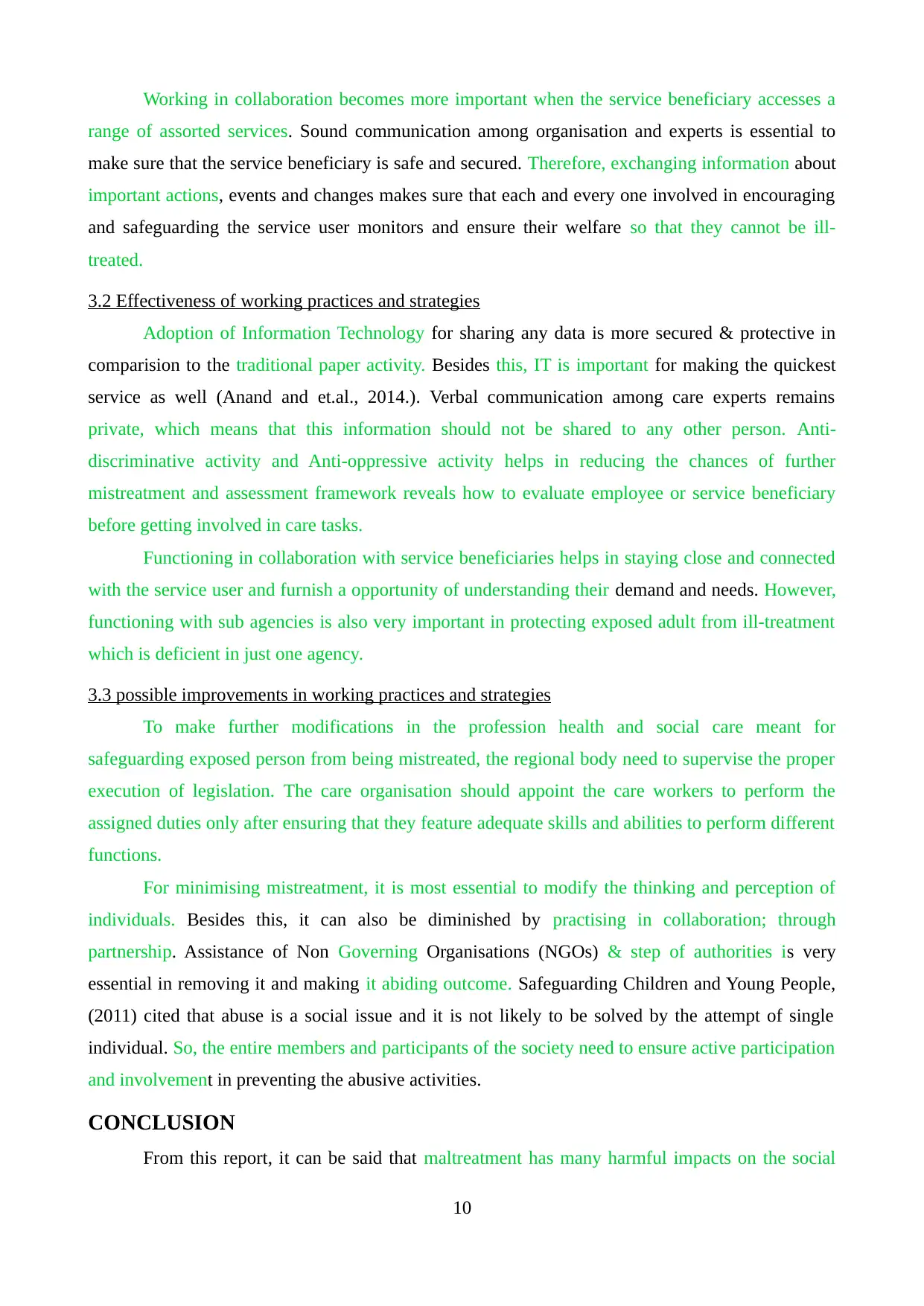
Working in collaboration becomes more important when the service beneficiary accesses a
range of assorted services. Sound communication among organisation and experts is essential to
make sure that the service beneficiary is safe and secured. Therefore, exchanging information about
important actions, events and changes makes sure that each and every one involved in encouraging
and safeguarding the service user monitors and ensure their welfare so that they cannot be ill-
treated.
3.2 Effectiveness of working practices and strategies
Adoption of Information Technology for sharing any data is more secured & protective in
comparision to the traditional paper activity. Besides this, IT is important for making the quickest
service as well (Anand and et.al., 2014.). Verbal communication among care experts remains
private, which means that this information should not be shared to any other person. Anti-
discriminative activity and Anti-oppressive activity helps in reducing the chances of further
mistreatment and assessment framework reveals how to evaluate employee or service beneficiary
before getting involved in care tasks.
Functioning in collaboration with service beneficiaries helps in staying close and connected
with the service user and furnish a opportunity of understanding their demand and needs. However,
functioning with sub agencies is also very important in protecting exposed adult from ill-treatment
which is deficient in just one agency.
3.3 possible improvements in working practices and strategies
To make further modifications in the profession health and social care meant for
safeguarding exposed person from being mistreated, the regional body need to supervise the proper
execution of legislation. The care organisation should appoint the care workers to perform the
assigned duties only after ensuring that they feature adequate skills and abilities to perform different
functions.
For minimising mistreatment, it is most essential to modify the thinking and perception of
individuals. Besides this, it can also be diminished by practising in collaboration; through
partnership. Assistance of Non Governing Organisations (NGOs) & step of authorities is very
essential in removing it and making it abiding outcome. Safeguarding Children and Young People,
(2011) cited that abuse is a social issue and it is not likely to be solved by the attempt of single
individual. So, the entire members and participants of the society need to ensure active participation
and involvement in preventing the abusive activities.
CONCLUSION
From this report, it can be said that maltreatment has many harmful impacts on the social
10
range of assorted services. Sound communication among organisation and experts is essential to
make sure that the service beneficiary is safe and secured. Therefore, exchanging information about
important actions, events and changes makes sure that each and every one involved in encouraging
and safeguarding the service user monitors and ensure their welfare so that they cannot be ill-
treated.
3.2 Effectiveness of working practices and strategies
Adoption of Information Technology for sharing any data is more secured & protective in
comparision to the traditional paper activity. Besides this, IT is important for making the quickest
service as well (Anand and et.al., 2014.). Verbal communication among care experts remains
private, which means that this information should not be shared to any other person. Anti-
discriminative activity and Anti-oppressive activity helps in reducing the chances of further
mistreatment and assessment framework reveals how to evaluate employee or service beneficiary
before getting involved in care tasks.
Functioning in collaboration with service beneficiaries helps in staying close and connected
with the service user and furnish a opportunity of understanding their demand and needs. However,
functioning with sub agencies is also very important in protecting exposed adult from ill-treatment
which is deficient in just one agency.
3.3 possible improvements in working practices and strategies
To make further modifications in the profession health and social care meant for
safeguarding exposed person from being mistreated, the regional body need to supervise the proper
execution of legislation. The care organisation should appoint the care workers to perform the
assigned duties only after ensuring that they feature adequate skills and abilities to perform different
functions.
For minimising mistreatment, it is most essential to modify the thinking and perception of
individuals. Besides this, it can also be diminished by practising in collaboration; through
partnership. Assistance of Non Governing Organisations (NGOs) & step of authorities is very
essential in removing it and making it abiding outcome. Safeguarding Children and Young People,
(2011) cited that abuse is a social issue and it is not likely to be solved by the attempt of single
individual. So, the entire members and participants of the society need to ensure active participation
and involvement in preventing the abusive activities.
CONCLUSION
From this report, it can be said that maltreatment has many harmful impacts on the social
10
Paraphrase This Document
Need a fresh take? Get an instant paraphrase of this document with our AI Paraphraser
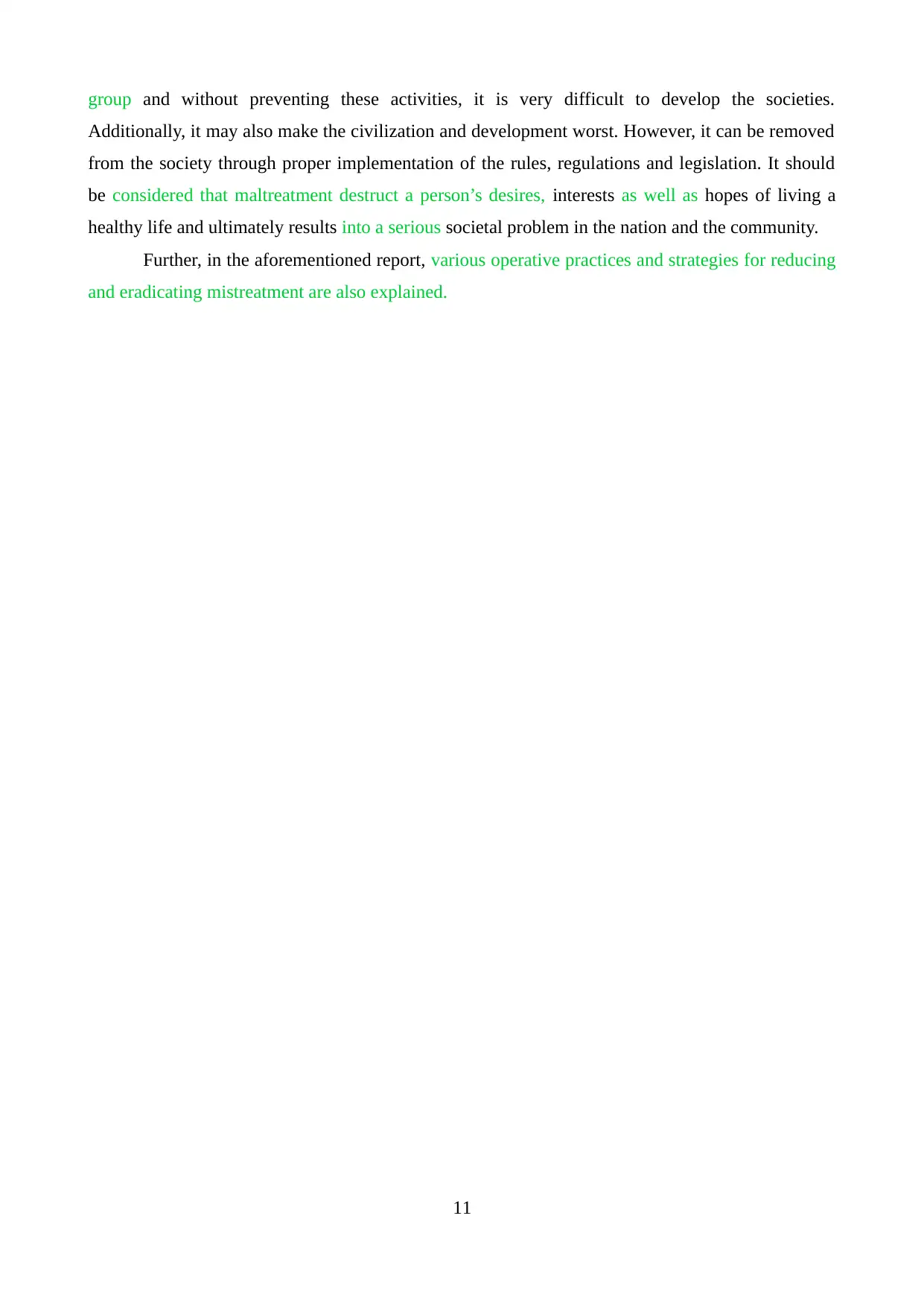
group and without preventing these activities, it is very difficult to develop the societies.
Additionally, it may also make the civilization and development worst. However, it can be removed
from the society through proper implementation of the rules, regulations and legislation. It should
be considered that maltreatment destruct a person’s desires, interests as well as hopes of living a
healthy life and ultimately results into a serious societal problem in the nation and the community.
Further, in the aforementioned report, various operative practices and strategies for reducing
and eradicating mistreatment are also explained.
11
Additionally, it may also make the civilization and development worst. However, it can be removed
from the society through proper implementation of the rules, regulations and legislation. It should
be considered that maltreatment destruct a person’s desires, interests as well as hopes of living a
healthy life and ultimately results into a serious societal problem in the nation and the community.
Further, in the aforementioned report, various operative practices and strategies for reducing
and eradicating mistreatment are also explained.
11
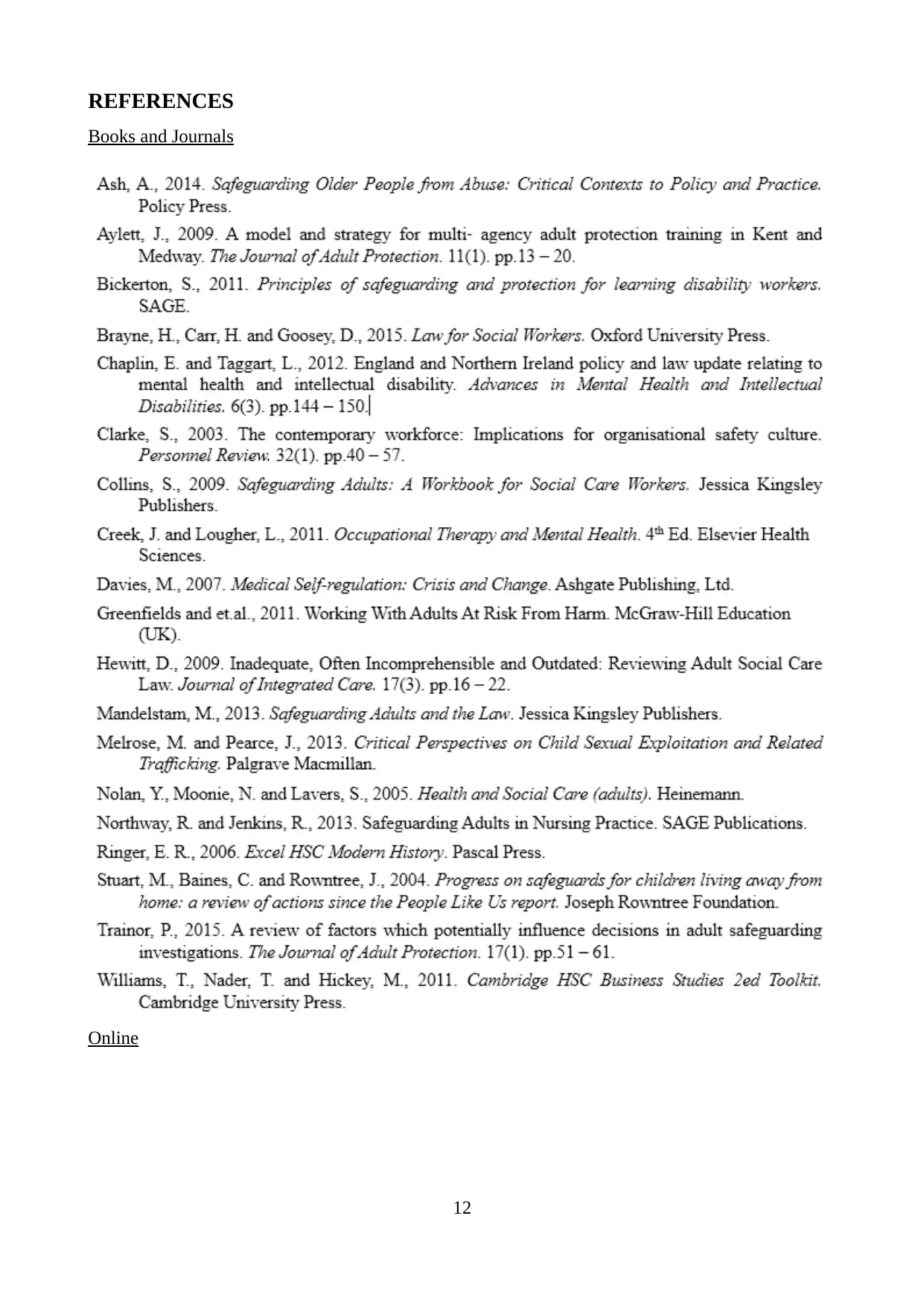
REFERENCES
Books and Journals
Online
12
Books and Journals
Online
12
⊘ This is a preview!⊘
Do you want full access?
Subscribe today to unlock all pages.

Trusted by 1+ million students worldwide
1 out of 13
Related Documents
Your All-in-One AI-Powered Toolkit for Academic Success.
+13062052269
info@desklib.com
Available 24*7 on WhatsApp / Email
![[object Object]](/_next/static/media/star-bottom.7253800d.svg)
Unlock your academic potential
Copyright © 2020–2025 A2Z Services. All Rights Reserved. Developed and managed by ZUCOL.





